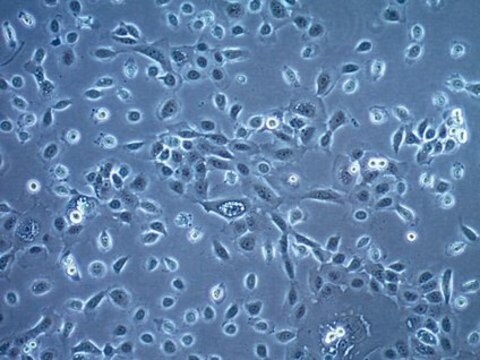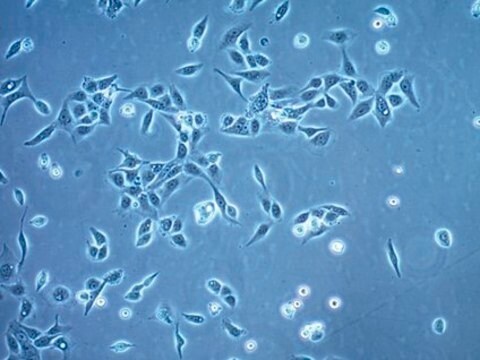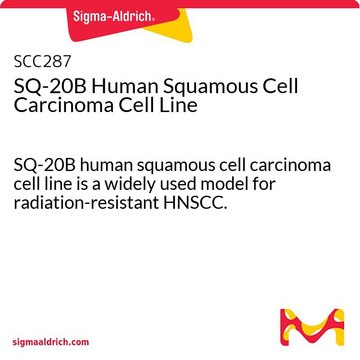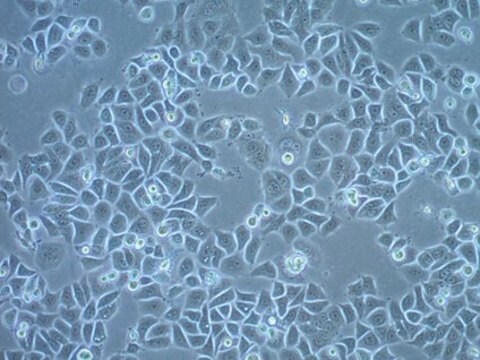SCC070
UM-SCC-1 Squamous Carcinoma Cell Line
Human
Synonim(y):
University Michigan Squamous Cell Carcinoma, UMSCC1, H&N squamous cell carcinoma cell line, Head and neck squamous cell carcinoma cell line, HNSCC
About This Item
Polecane produkty
product name
UM-SCC-1 Squamous Carcinoma Cell Line, UM-SCC-1 is a unique human head and neck squamous cell carcinoma (HNSCC) cell line isolated from a tumor located on the floor of the mouth of a male patient and is a suitable in vitro model of H&N carcinoma studies.
pochodzenie biologiczne
human
Poziom jakości
metody
cell culture | mammalian: suitable
Warunki transportu
liquid nitrogen
Opis ogólny
THIS PRODUCT IS ONLY AVAILABLE FOR SALE TO ACADEMIC INSTITUTIONS OR NOT-FOR-PROFIT ENTITIES FOR USE UNDER THIS LIMITED USE LABEL LICENSE. FOR INFORMATION ON COMMERCIAL LICENSING OF UM-SCC CELLS, INCLUDING LICENSING TO COMMERCIAL ENTITIES, PLEASE CONTACT: licensing@emdmillipore.com
Head and neck squamous cell carcinoma (HNSCC) develops from the mucosal linings of the upper aerodigestive tract, comprising 1) the nasal cavity and paranasal sinuses, 2) the nasopharynx, 3) the hypopharynx, larynx, and trachea, and 4) the oral cavity and oropharynx. Squamous cell carcinoma (SCC) is the most frequent malignant tumor of the head and neck region. HNSCC is the sixth leading cancer by incidence worldwide. There are 500,000 new cases a year worldwide and two thirds occur in industrialized nations. It is caused by tobacco and alcohol consumption and infection with high-risk types of human papillomavirus (HPV). SCC often develops from preexisting dysplastic lesions. The five-year survival rate of patients with HNSCC is about 40-50%.
UM-SCC-1 is a unique head and neck squamous carcinoma cell line isolated from the tumor located on the floor of the mouth of a male patient. The cell line is negative for HPV-16 and for HLA-A2, a class I molecule of the major histocompatibility complex (MHC). The UM-SCC-1 cell line is 50% more invasive in vitro and displays a greater propensity for perineural and lymphatic invasion in vivo.
UM-SCC-1 was established at the University of Michigan (1) with written informed consent obtained from the patient and with the approval of the study by the Medical School Institutional Review Board.
Reference:
1) Carey, T., et al. (2012) Genotyping of 73 UM-SCC head and neck squamous cell carcinoma cell lines. Head Neck. 2010 April; 32(4): 417–426.
Komponenty
Jakość
• Cells are tested by PCR and are negative for HPV-16, HPV-18, Hepatitis A, B, C and HIV-1 & 2 viruses.
• Cells are negatrive for mycoplasma contamination.
• Each lot of cells are genotyped by STR analysis to verify the unique identity of the cell line.
Przechowywanie i stabilność
Oświadczenie o zrzeczeniu się odpowiedzialności
Kod klasy składowania
10 - Combustible liquids
Klasa zagrożenia wodnego (WGK)
WGK 1
Temperatura zapłonu (°F)
Not applicable
Temperatura zapłonu (°C)
Not applicable
Certyfikaty analizy (CoA)
Poszukaj Certyfikaty analizy (CoA), wpisując numer partii/serii produktów. Numery serii i partii można znaleźć na etykiecie produktu po słowach „seria” lub „partia”.
Masz już ten produkt?
Dokumenty związane z niedawno zakupionymi produktami zostały zamieszczone w Bibliotece dokumentów.
Nasz zespół naukowców ma doświadczenie we wszystkich obszarach badań, w tym w naukach przyrodniczych, materiałoznawstwie, syntezie chemicznej, chromatografii, analityce i wielu innych dziedzinach.
Skontaktuj się z zespołem ds. pomocy technicznej







